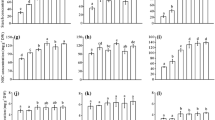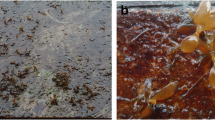Abstract
Carbon and nitrogen balance in Acorus calamus, a wetland species colonising littoral zones with a high trophic status, was studied under experimental conditions using water or sand culture with a defined composition of the nutrient solution. Influence of graded level of N (1.86, 7.5 and 18.6 mM) and/or forms of N (NH +4 versus NO –3 ) on the content of non-structural carbohydrates, free amino acids, total C, and total N was studied in Acorus rhizomes and roots to find possible connection with a reduced growth of Acorus plants under high N and NH +4 –N nutrition described in our previous study [Vojtíšková et al., 2004. Hydrobiologia 518: 9–22]. High N availability and pure NH +4 –N nutrition affected the C/N balance of rhizome and root systems of Acorus in a similar way. NH +4 –N was the only form of N elevated under the high N treatment. The major proportion of the total non-structural carbohydrates (TNC) was starch (91–93% and 51–64% in rhizomes and roots, respectively). The content of starch was significantly and and negatively affected by high N availability (P = 0.001), as well as by NH +4 –N nutrition (P=0.001). Amounts of simple soluble carbohydrates (sucrose, glucose, and fructose) were negligible in comparison to starch in rhizomes and branched roots (up to 5% of TNC), while roots without developed lateral roots (unbranched) contained up to 33% of TNC in the form of simple soluble sugars. Moreover, high hexoses/sucrose ratio, low starch/soluble sugars ratio, high content of N, and low C/N ratio support the notion that unbranched roots are metabolically active young roots with tissue differentiation in progress. A high content of free amino acids, typically with dominance of N-rich amino acids (Arg-46%, Gln-8%, Asn-7%), was found simultaneously with a low carbohydrate content under high N supply, which indicates that NH +4 received is effectively incorporated into the organic form by this species. Since the decrease in carbohydrate content was not accompanied by luxurious growth, other possible carbon consuming processes were discussed in relation to NH +4 nutrition. More dramatic changes in total N than C were found under high N availability resulting a shift in C/N ratio in favour of N. Although the shift towards N metabolism was obvious, no serious carbohydrate depletion occurred, which could explain the reduced growth of Acorus plants under high N and sole NH +4 –N nutrition described previously.
Similar content being viewed by others
References
Barclay A. M. and Crawford R. M. M. (1982). Plant-growth and survival under strict anaerobiosis. Journal of Experimental Botany 33: 541–549
Barclay A. M. and Crawford R. M. M. (1983). The effect of anaerobiosis on carbohydrate-levels in storage tissues of wetland plants. Annals of Botany 51: 255–259
Bindon K. A. and Botha F. C. (2002). Carbon allocation to the insoluble fraction, respiration and triose-phosphate cycling in the sugarcane culm. Physiologia Plantarum 116: 12–19
Brändle R. (1991). Flooding resistance of rhizomatous amphibious plants. In: Jackson, M. B., Davies, D. D. and Lambers, H. (eds) Plant Life under Oxygen Deprivation, pp 35–46. SPB Academic Publishing bv, The Hague, The Netherlands
Brändle R., Pokorný J., Květ J. and Čížková H. (1996). Wetland plants as a subject of interdisciplinary research. Folia Geobotanica and Phytotaxonomica 31: 1–6
Britto D. T., Siddiqi M. Y., Glass A. D. M. and Kronzucker H. J. (2001). Futile transmembrane NH +4 cycling: a cellular hypothesis to explain ammonium toxicity in plants. Proceedings of the National Academy of Sciences of the United States of America 98: 4255–4258
Cramer M. D. and Lewis O. A. M. (1993a). The influence of NO −3 and NH +4 nutrition on the carbon and nitrogen partitioning characteristics of wheat (Triticum aestivum L.) and maize (Zea mays L.) plants. Plant and Soil 154: 289–300
Cramer M. D. and Lewis O. A. M. (1993b). The influence of NO −3 and NH +4 nutrition on the gas-exchange characteristics of the roots of wheat (Triticum aestivum) and maize (Zea mays) plants. Annals of Botany 72: 37–46
Cramer M. D. and Lewis O. A. M. (1993c). The influence of nitrate and ammonium nutrition on the growth of wheat (Triticum aestivum) and maize (Zea mays) plants. Annals of Botany 72: 359–365
Cramer M. D., Lewis O. A. M. and Lips S. H. (1993). Inorganic carbon fixation and metabolism in maize roots as affected by nitrate and ammonium nutrition. Physiologia Plantarum 89: 632–639
Crawford R. M. M. and Brändle R. (1996). Oxygen deprivation stress in a changing environment. Journal of Experimental Botany 47: 145–159
Čížková-Končalová H., Květ J. and Lukavská J. (1996). Response of Phragmites australis, Glyceria maxima, and Typha latifolia to additions of piggery sewage in a flooded sand culture. Wetland Ecology and Management 4: 43–50
Čížková-Končalová H., Květ J. and Thompson K. (1992). Carbon Starvation – a key to reed decline in eutrophic lakes. Aquatic Botany 43: 105–113
Čížková H. and Bauer V. (1998). Rhizome respiration of Phragmites australis: effect of rhizome age, temperature and nutrient status of the habitat. Aquatic Botany 61: 239–253
Čížková H., Istvanovics V., Bauer V. and Balazs L. (2001a). Low levels of reserve carbohydrates in reed (Phragmites australis) stands of Kis-Balaton, Hungary. Aquatic Botany 69: 209–216
Čížková H., Lukavská J., Přibáň K., Kopecký J. and Brabcová H. (1996). Carbohydrate levels in rhizomes of Phragmites australis at an oligotrophic and a eutrophic site: a preliminary study. Folia Geobotanica and Phytotaxonomica 31: 111–118
Čížková H., Pechar L., Husák S., Květ J., Bauer V., Radová J. and Edwards K. (2001b). Chemical characteristics of soils and pore waters of three wetland sites dominated by Phragmites australis: relation to vegetation composition and reed performance. Aquatic Botany 69: 235–249
Dykyjová D. (1979). Selective uptake of mineral ions and their concetration factors in aquatic higher plants. Folia Geobotanica and Phytotaxonomica 14: 267–325
Dykyjová D. (1980). Production ecology of Acorus calamus. Folia Geobotanica and Phytotaxonomica 15: 29–57
Haldemann C. and Brändle R. (1986). Seasonal-variations of reserves and of fermentation processes in wetland plant rhizomes at the natural site. Flora 178: 307–313
Haldemann C. and Brändle R. (1988). Amino-acid composition in rhizomes of wetland species in their natural habitat and under anoxia. Flora 180: 407–411
Hejný S. and Husák S. (1978). Higher plant communities. In: Dykyjová, D. and Květ, J. (eds) Pond Littoral Ecosystems-Structure and Functioning, pp 23–64. Springer-Verlag, Berlin Heidelberg New York
Hintze J. (2001). NCSS and PASS. Number Cruncher Statistical Systems. Kaysville, Utah
Kohl J. G., Woitke P., Kühl H., Dewender M. and König G. (1998). Seasonal changes in dissolved amino acids and sugars in basal culm internodes as physiological indicators of the C/N-balance of Phragmites australis at littoral sites of different trophic status. Aquatic Botany 60: 221–240
Končalová H., Květ J., Pokorný J. and Hauser V. (1993). Effect of flooding with sewage water on three wetland sedges. Wetlands Ecology and Management 2: 199–211
Kubín P. and Melzer A. (1996). Does ammonium affect accumulation of starch in rhizomes of Phragmites australis (Cav) Trin ex Steud?. Folia Geobotanica and Phytotaxonomica 31: 99–109
Kühl H. and Kohl J. G. (1992). Nitrogen accumulation, productivity and stability of reed stands Phragmites australis (Cav.) Trin. ex Steudel at different lakes and sites of the lake districts of Uckermark and Mark Brandenburg (Germany). Internationale Revue der Gesamten Hydrobiologie 77: 85–107
MacRae J. L. (1971). Quantitative measurement of starch in very small amounts of leaf tissue. Planta 96: 101–108
Marschner H. (1995). Mineral Nutrition of Higher Plants, Nitrogen. Academic Press, London, pp 231–255
Matsumoto H., Wakiuchi N. and Takahashi E. (1968). Changes of sugar levels in cucumber leaves during ammonium toxicity. Physiologia Plantarum 21: 1210–1216
McCready R. M., Guggolz J., Silveira V. and Owens S. (1950). Determination of starch and amylose in vegetables. Analytical Chemistry 22: 1156–1158
Miyachi S. and Miyachi S. (1987). Some biochemical-changes related to starch breakdown induced by blue-light illumination and by addition of ammonia to Chlorella cells. Plant and Cell Physiology 28: 309–314
Monk L. S., Crawford R. M. M. and Brändle R. (1984). Fermentation rates and ethanol accumulation in relation to flooding tolerance in rhizomes of monocotyledonous species. Journal of Experimental Botany 35: 738–745
Peuke A. D. and Jeschke W. D. (1993). The uptake and flow of C, N and ions between roots and shoots in Ricinus-communis L.1. Grown with ammonium or nitrate as nitrogen-source. Journal of Experimental Botany 44: 1167–1176
Romero J. A., Brix H. and Comin F. A. (1999). Interactive effects of N and P on growth, nutrient allocation and NH4 uptake kinetics by Phragmites australis. Aquatic Botany 64: 369–380
Saarinen T. (1998). Internal C:N balance and biomass partitioning of Carex rostrata grown at three levels of nitrogen supply. Canadian Journal of Botany 76: 762–768
Sima B. D. and Desjardins Y. (2001). Sucrose enhances phosphoenolpyruvate carboxylase activity of in vitro Solanum tuberosum L. under non-limiting nitrogen conditions. In Vitro Cellular and Developmental Biology – Plant 37: 480–489
Steinmann F. and Brändle R. (1984). Carbohydrate and protein-metabolism in the rhizomes of the bulrush (Schoenoplectus-lacustris (L) Palla) in relation to natural development of the whole plant. Aquatic Botany 19: 53–63
Teyker R. H. and Hobbs D. C. (1992). Growth and root morphology of corn as influenced by nitrogen form. Agronomy Journal 84: 694–700
Vojtíšková L., Munzarová E., Votrubová O., Říhová A. and Juřicová B. (2004). Growth and biomass allocation of sweet flag (Acorus calamus L.) under different nutrient conditions. Hydrobiologia 518: 9–22
Votrubová O. and Pecháčková A. (1996). Effect of nitrogen over-supply on root structure of common reed. Folia Geobotanica and Phytotaxonomica 31: 119–125
Wang M. Y., Siddiqi M. Y., Ruth T. J. and Glass A. D. M. (1993). Ammonium uptake by rice roots. 2. Kinetics of NH +4 –N−13 influx across the plasmalemma. Plant Physiology 103: 1259–1267
Weber M. and Brändle R. (1994). Dynamics of nitrogen-rich compounds in roots, rhizomes and leaves of the sweet flag (Acorus-calamus L) at its natural site. Flora 189: 63–68
Weber M. and Brändle R. (1996). Some aspects of the extreme anoxia tolerance of the sweet flag Acorus calamus L. Folia Geobotanica and Phytotaxonomica 31: 37–46
Author information
Authors and Affiliations
Corresponding author
Rights and permissions
About this article
Cite this article
Vojtíšková, L., Munzarová, E., Votrubová, O. et al. The Influence of Nitrogen Nutrition on the Carbohydrate and Nitrogen Status of Emergent Macrophyte Acorus calamus L.. Hydrobiologia 563, 73–85 (2006). https://doi.org/10.1007/s10750-005-0929-3
Received:
Revised:
Accepted:
Published:
Issue Date:
DOI: https://doi.org/10.1007/s10750-005-0929-3




